Review: 2018 Ducati Scrambler Desert Sled
The Ducati Scrambler Desert Sled looks the business and offers some off-road prowess into the mix, what's not to like? Words by Kris Hodgson, Images by Heather Ware, Kris Hodgson
Ducati’s Scrambler line has seen strong success, on the back of what is basically a no frills option that harkens back to the days of simple motorcycling. There’s no extensive electronics package, standard ABS, and specifications for a Ducati are almost basic.
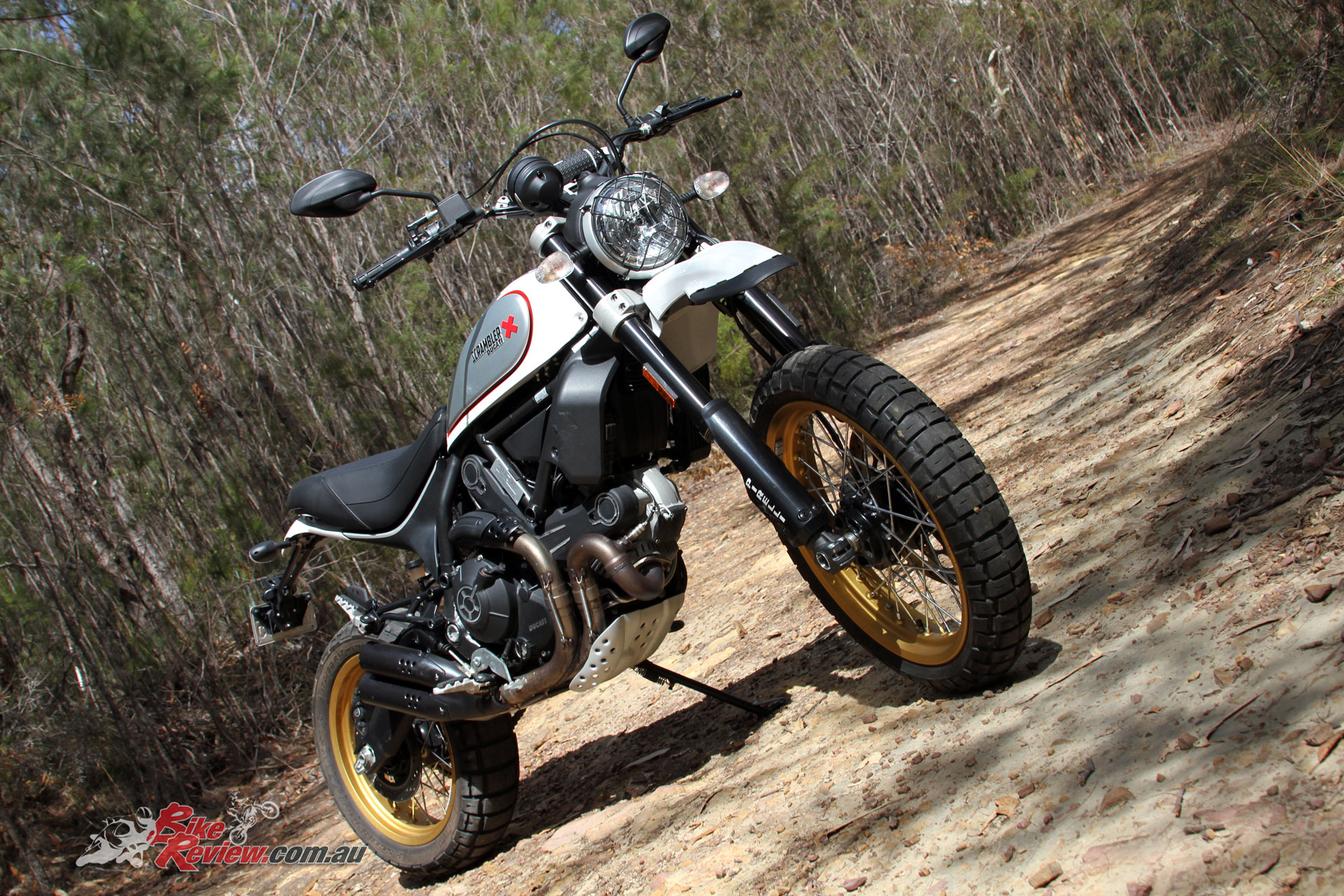
The Scrambler Desert Sled looks the business, but despite the off-road orientation is great on the tarmac
It’s easy to totally miss the point when you consider the Scrambler like this, and you’d be missing a good point too. The Desert Sled is inspired by the custom machines that took the same name in America, which were essentially desert racers. Straight up it looks very cool and there’s a massive accessories range to pick from.
The V-Twin engine is a characterful 803cc of fun and interesting performance, with 73hp on tap and 49 lb-ft of torque on offer. The gearbox is on the clunky side, but the cable operated clutch is light and smooth and accessing that ample power couldn’t be easier.
Low down performance is strong and punchy with what feels like shorter gearing than the standard Scramblers, while the Desert Sled will continue powering along way past the legal limits, meaning you’ve got fun torque to play around with down low, and a somewhat more restrained/linear top end, that is more than up to the task for canyon cutting.
Adjustable suspension is compliant but sporty on the road, and ideal through the twisties, but on standard settings it is set-up for the road. Simon Leplaw from Ducati was quick to point out that the Desert Sled is a soft off-roader, and while our local testing ground is a pretty rough example of such, it demonstrated this well. With it’s weight limiting serious off road ability, the Desert Sled is a good compromise and will allow the owner to have a bit of fun between road stints or in the countryside.
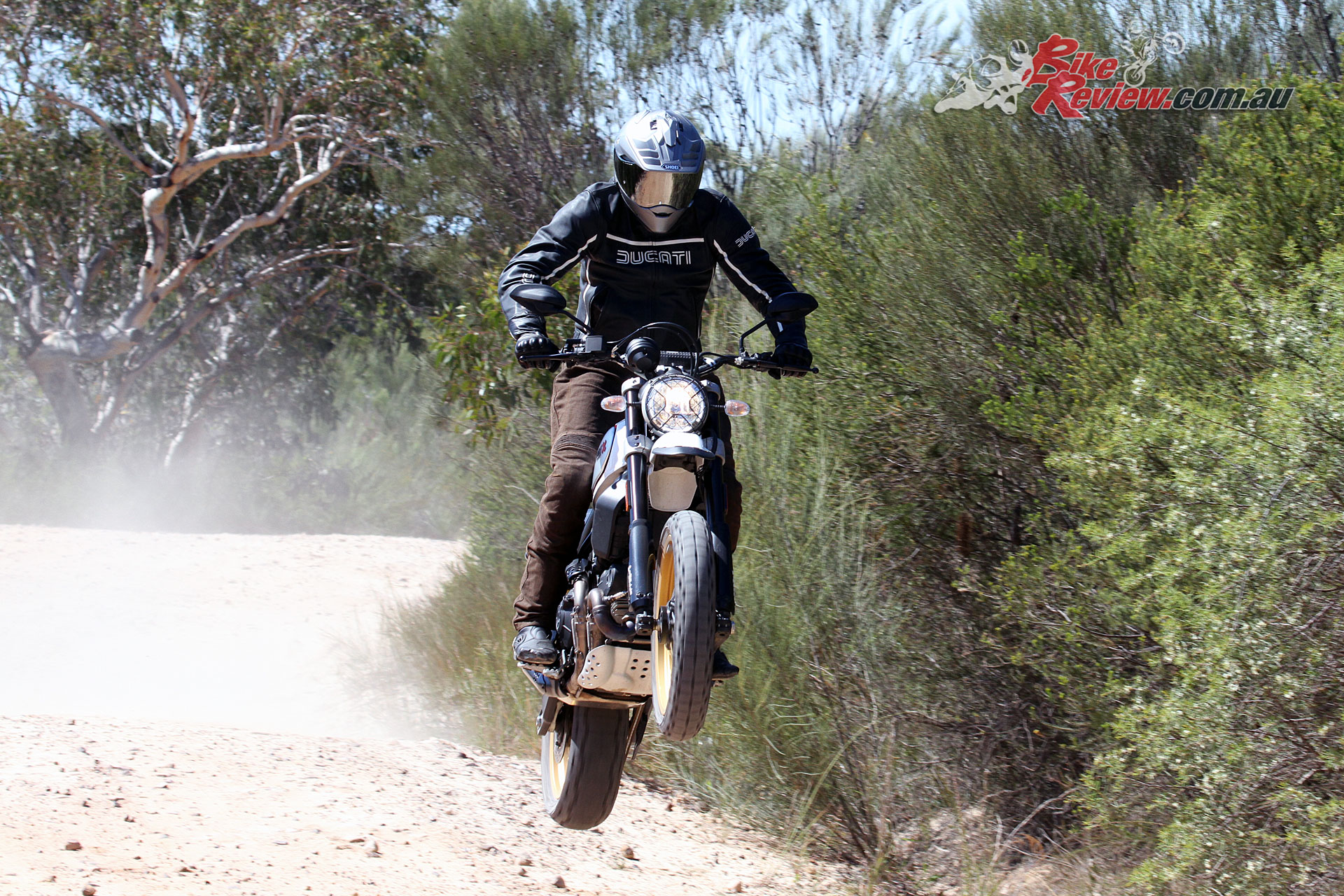
Standard suspension is set for a sporty road ride, but there’s plenty of adjustability for a more off-road orientated setup
With 80 per cent of riding on the tarmac and 20 per cent on unsealed sections I didn’t worry about trying to adjust the suspension or tyre pressures for the off-road experience. The adjustability is there if you wanted to provide a softer off-road experience (or need to tweak it for your weight), but it’s so good on the road that I’d be hesitant to do so unless that was the majority of my riding.
With the wider ‘bars and taller front end and overall ergonomics the Desert Sled also makes standing up on the ‘pegs natural, and for barreling along a fire trail this was how I chose to travel, with the full weight through the ‘pegs ensuring a relatively smooth, controllable ride as I hit rocks a fair bit larger than my fist – they were pretty much unavoidable in some sections.
Sitting down in the saddle didn’t offer anywhere near as nice an experience on the rough stuff of course but on the open dirt roads soaking up the miles sitting down is no issue.
Brakes are Brembo items, with a single front 330mm rotor and four-piston caliper, while the rear sports a 245mm rotor with single-piston caliper. That offers enough braking performance for my needs, although when you’re really going to the extremes of giving the brakes a workout you’ll find the limitations on sealed roads.
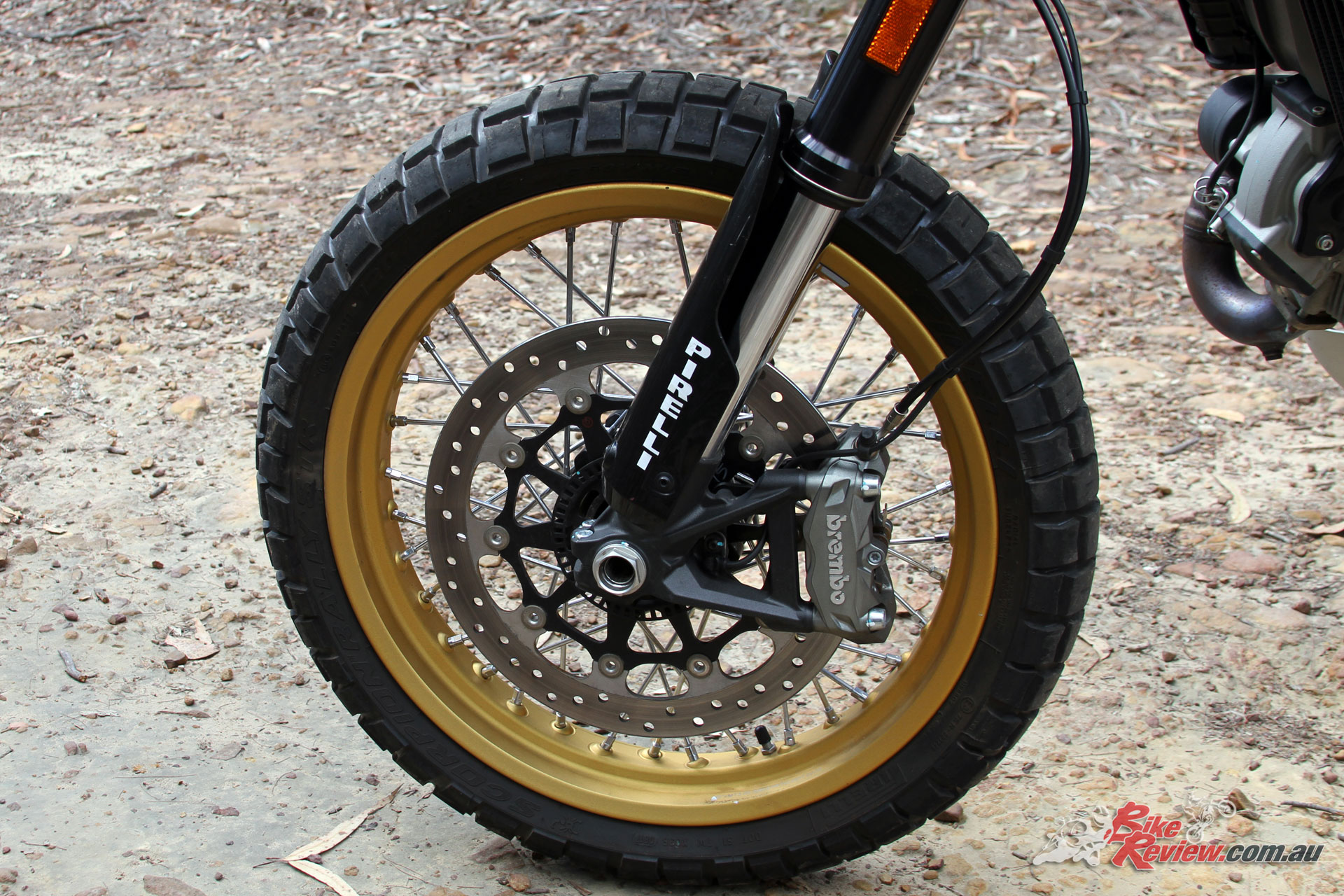
There’s strong performance from the Brembo brakes, with a single rotor front and rear, with spoked wheels clad in Scorpion Rally STR rubber
Do I consider that a problem? No, it’s a well-balanced system for the road, and won’t catch you out off-road and being able to easily identify those limits means there’s great feedback. I couldn’t get the ABS to activate on the tarmac either, with that clear indication of the limit of the front coming into play, while a few quick stops on the dirt were fuss free when the ABS come into play but it would be good to switch it off on the dirt to provide better control.
New for the Desert Sled is the Pirelli Scorpion Rally STR tyres, on spoked wheels, which include a 19in front and 17in rear. Grip on the road was exceptional, with a quick transition onto the side of the tyre, but great stability once you got there. This ensures an engaging ride, and adds a bit of character, working well with that slightly raw aspect of the V-twin engine. I didn’t get a chance to test the tyres in the wet, but would be interested to see how they’d perform in that situation.
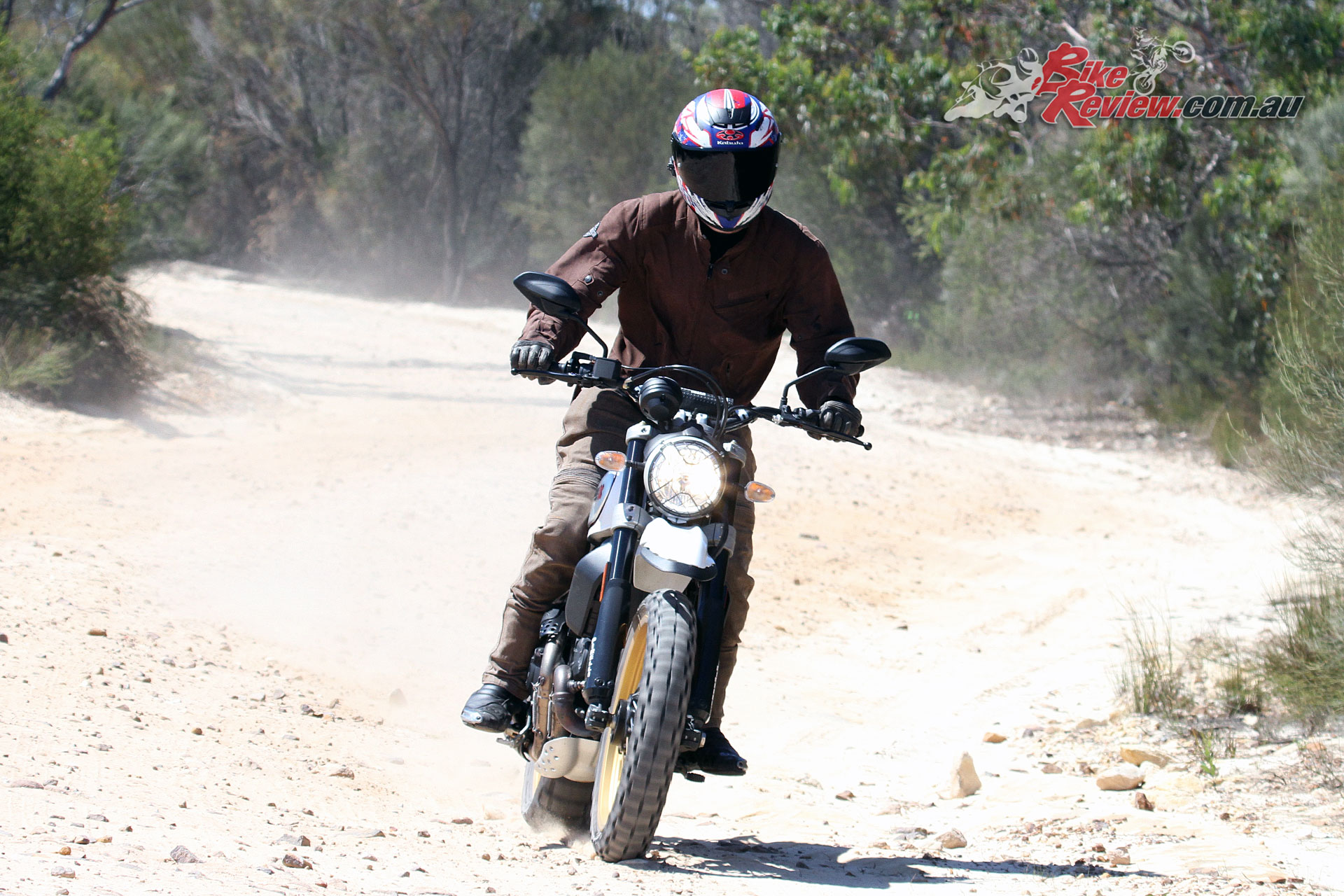
Standing up off-road offers comfortable ergonomics and control, with ideal ‘bar height and ‘peg placement
Other chassis modifications unique to the Desert Sled include a new, longer aluminium swingarm, reinforced trellis frame, new chain guard and a rear sprocket protector, while the previously mentioned suspension is beefed up 46mm KYB forks, with longer travel available at both ends at 200mm.
Overall ergonomics are also comfortable, with a nice wide single-piece seat, that has generous room for a pillion, with rubber clad ‘pegs also helping quell any vibration, although these were very minimal.
The single dash is again a simple LCD item but speed is highly visible, while the tacho running the bottom edge of the screen is largely unnecessary for this engine layout, as you quickly know by feel where you are in the rev range, and there’s little risk of accidentally hitting the limiter in anything resembling normal riding.
The ‘bars are quite wide, which for freeway riding can have you stretched out a little, increasing your surface area, and as a result the level of wind buffeting becomes noticeable after half an hour or so at 110km/h. In fact for shorter trips of one to two hours the Desert Sled is comfortable, however having spent up to six hours in the saddle I would say it’s more orientated towards these shorter trips, rather than long distance touring.
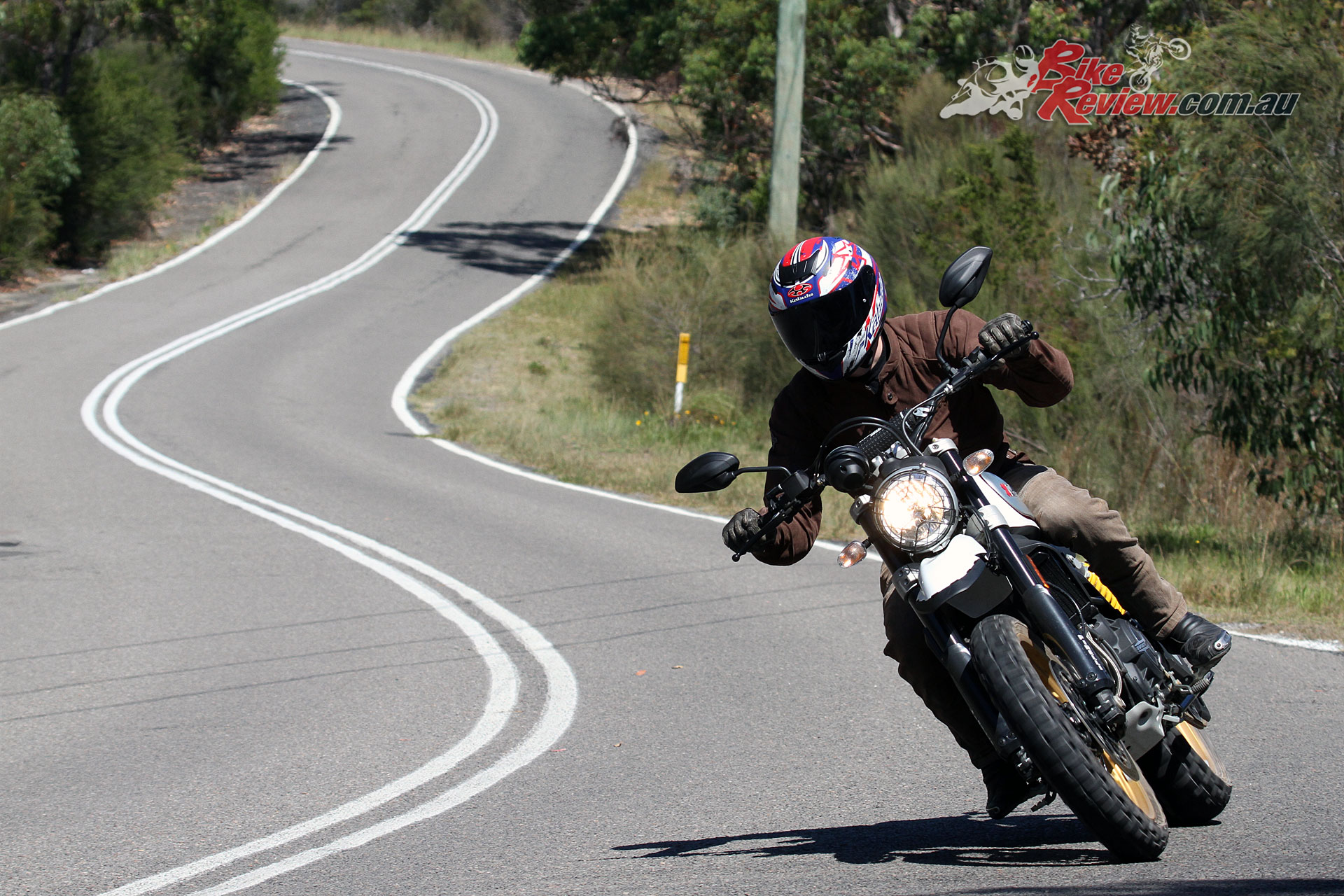
Overall the Scrambler Desert Sled is formidable and fun on the road, with plenty of character while offering the ability to explore the rough stuff without a worry
CONCLUSION
I’ve always enjoyed what Ducati have done with the Scrambler, it’s a versatile option and like I’ve already said, harkens back to a simpler time. I’d say I’m not alone in appreciating that either, with this kind of machine proving popular across many categories, and the Desert Sled may be a niche offering within that concept, but it’s a fun and characterful ride.
Styling is great, and the finish quality typical of Ducati. My only criticism was the headers had some discolouration, but the exhaust muffler is a cool blacked out low dual pipe setup, and there’s plenty of other great features, like the gold rims, tidy tail, generous undertail clearance, and front headlight guard.
So if you’re after something a bit different take a good long look at the Ducati Scrambler Desert Sled, it’s not meant to be a hardcore off-roader, but it’s an awesome on-roader, and it’s got a bit of extra off-road prowess too, with the looks to match. The only downside is the extra premium you’ll be paying over many of the other Scrambler offerings.
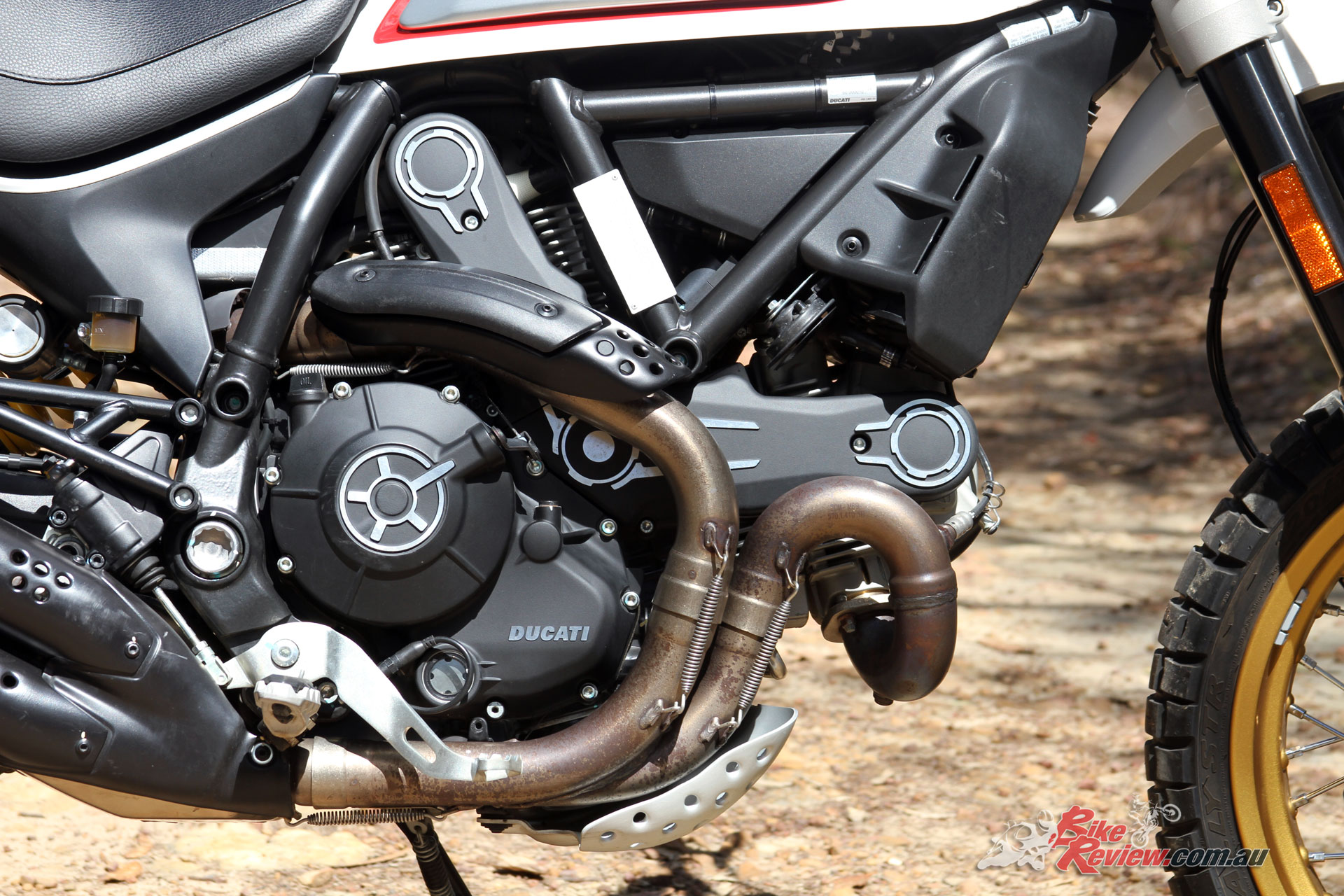
The 803cc air-cooled Desmodromic L-Twin powerplant is the heart of the Scrambler line and really is a versatile engine
Ducati Scrambler Desert Sled Tech Talk
Ducati’s Desert Sled is a larger departure from the base Scrambler template than many of the other offerings in the line, incorporating features to make it a more formidable off-road option. With exploring the unbeaten path the aim, the Desert Sled features a 19in front wheel and 17in rear, both wire spoke wheels, and clad in Pirelli Scorpion Rally STR rubber.
Suspension on the front is beefed up 46mm KYB forks, compared to the standard 41mm items found on the standard Scrambler, with full adjustability, and the rear offers pre-load and rebound adjustability, with 200mm travel at both ends, for a more off-road friendly ride.
The chassis has also been modified, with a new longer aluminium swingarm, while the trellis frame has been strengthened and reinforced to cope with the greater demands of possible off-roading.
Tall and wide ‘bars with a crossbar are also featured, with a foam protector on the crossbar emblazoned with the Ducati Scrambler name, while a headlight grill is standard fitment. The Desert Sled also features it’s own seat, a single piece affair with room for a pillion and with a 860mm seat height, while the front mudguard is a new high clearance version, in the off-road theme.
Standard features include the 803cc air-cooled Desmodromic L-Twin powerplant, single disc brake front and rear, both Brembo and with ABS as standard fitment, plus an LCD display, interchangeable tank side panels and a huge range of available accessories from Ducati.
2018 Ducati Scrambler Desert Sled Specifications (White/Black)
Price: $17,190 ($17,490) +ORC
Warranty: 24-month, unlimited kilometre
Service Interval/Valve Clearance check: 12,000km
Engine: Air-cooled, L-Twin, Desmodromic, two-valves per cylinder, 803cc, 88 x 66mm bore x stroke, 11:1 compression ratio, Stainless steel muffler, aluminium tail pipes, EFI, 50mm throttle-body
Claimed Power: 54kW(73hp)@8250 rpm
Claimed Torque: 67Nm (49lb-ft)@5750 rpm
Gearbox: Six-speed
Final drive: Chain; Front sprocket 15; Rear sprocket 46
Clutch: APTC wet multiplate with mechanical control
Frame: Tubular steel Trellis frame, aluminium double-sided swingarm
Suspension: 46mm fully adjustable USD forks, 200mm travel, Kayaba rear shock, pre-load and rebound adjustable, 200mm travel
Wheels: Spoked aluminium, 3.00 x 19in, 4.50 x 17in
Tyre: Pirelli Scorpion Rally STR 120/70 R19, 170/60 R17
Brakes: ABS, 330mm front rotors, radial four-piston Brembo calipers, 245mm rear rotor, single-piston floating Brembo caliper
DIMENSIONS:
Wheelbase: 1505mm
Rake: 24°
Trail: 112mm
Steering lock: 35°
Fuel tank capacity: 13.5L
Claimed dry weight: 191kg
Claimed wet weight: 207kg
Seat height: 860 mm
Max height: 1213mm
Max width: 940mm
Max length: 2200mm
EQUIPMENT
Steel tank with interchangeable aluminium side panels, headlight with homologate grill, LED light-guide, LED rear light, LCD instruments, machine-finished aluminium belt covers, under-seat storage compartment with USB socket, aluminium handlebar with cross-strut, front stem protectors, high front mudguard, long rear mudguard and high plate support
2018 Ducati Scrambler Desert Sled Gallery
The Verdict | Review: 2018 Ducati Scrambler Desert Sled
Explorer!
The Ducati Scrambler Desert Sled features a reinforced chassis, lengthened swingarm, beefed up long travel suspension and the ergonomics for some great off-road exploring, making it an eye catching option with the performance to match…




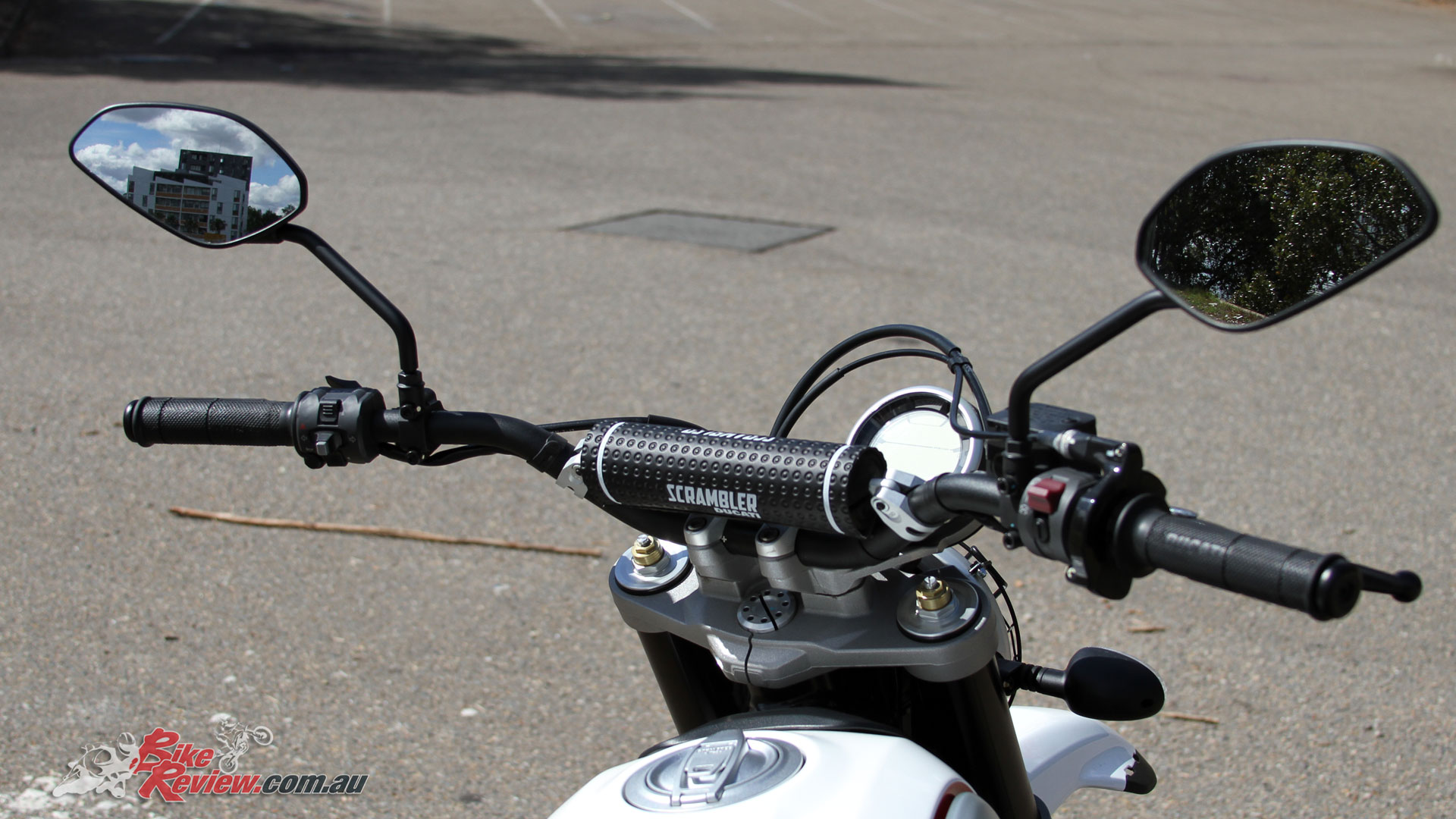

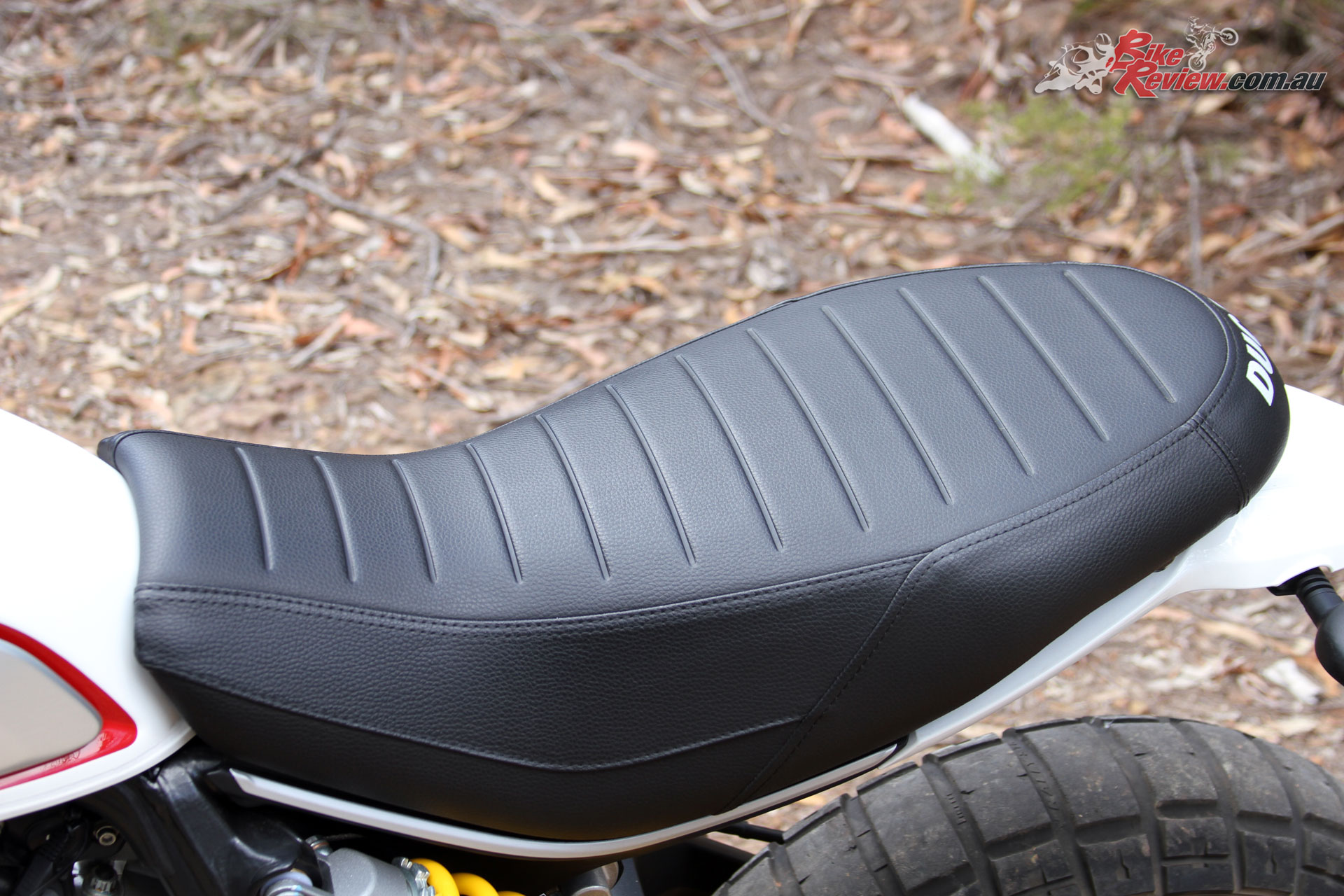


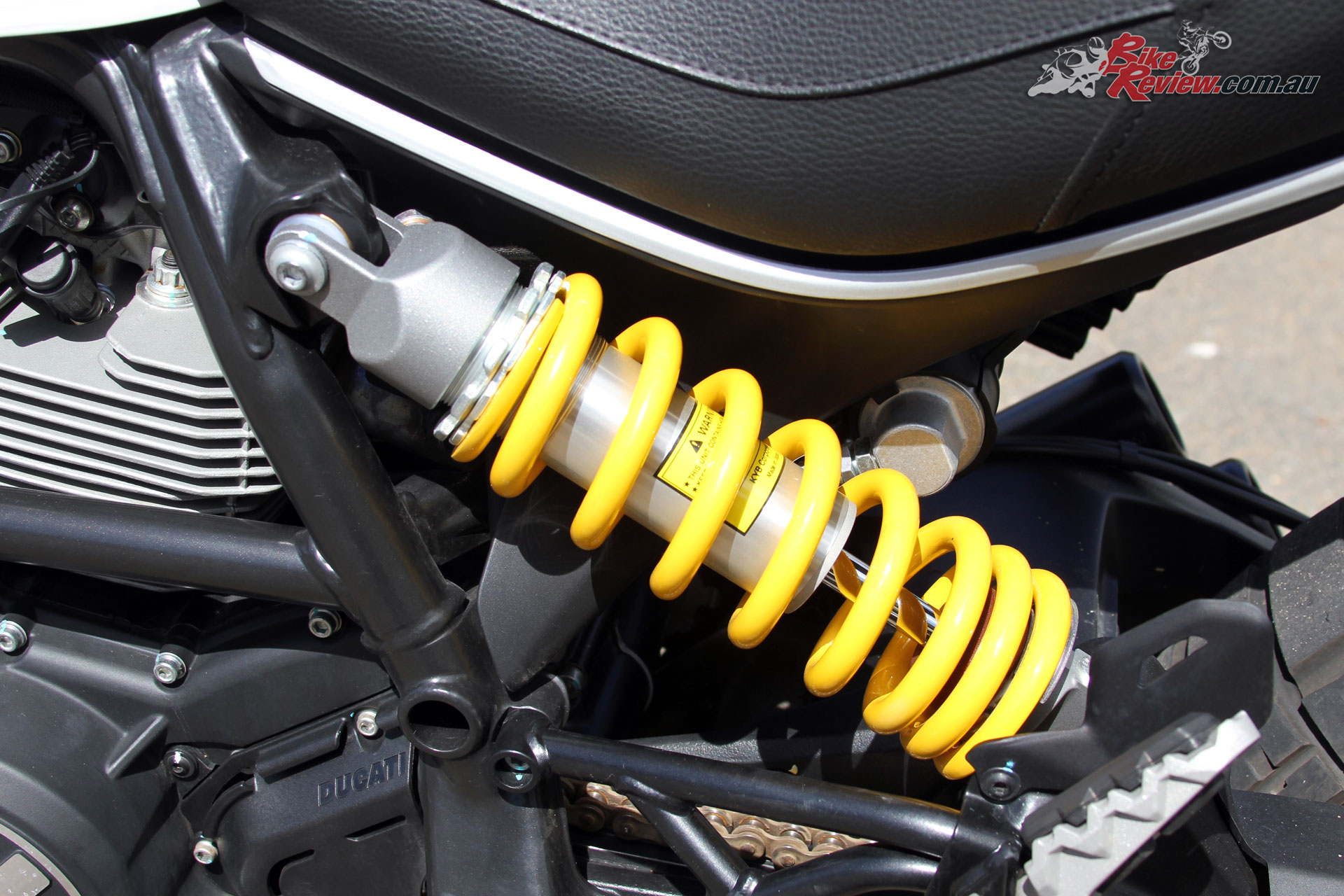


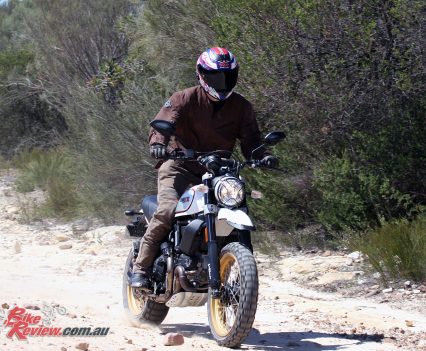
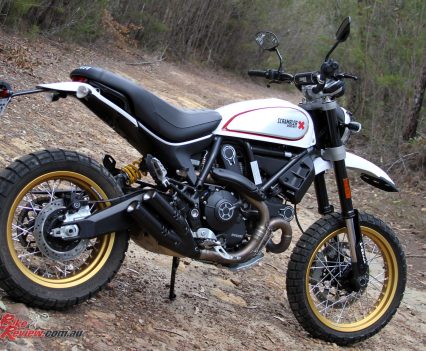
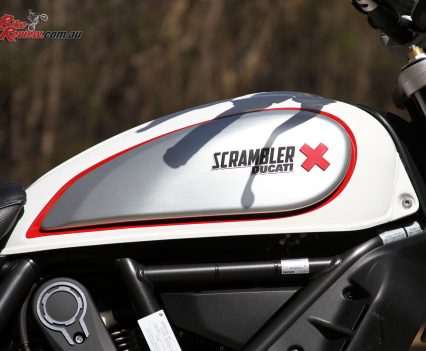
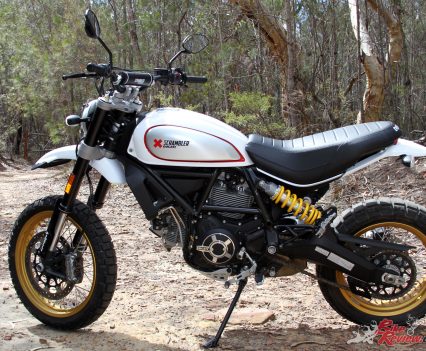
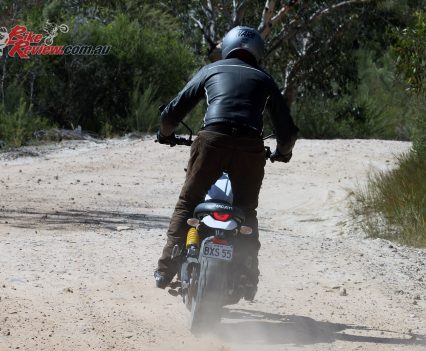
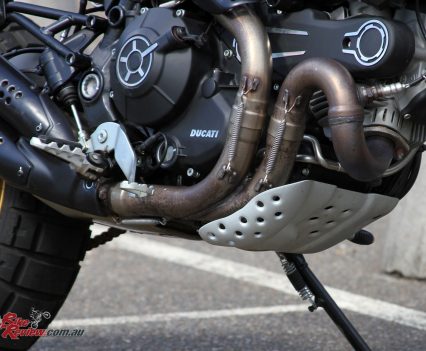
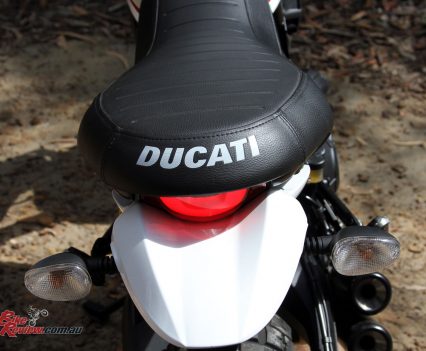
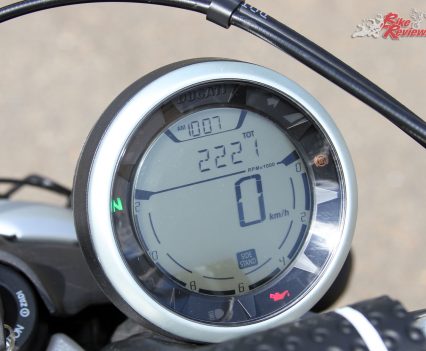
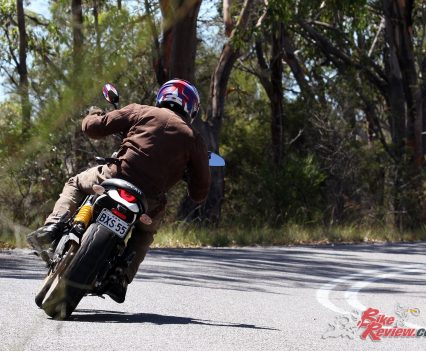
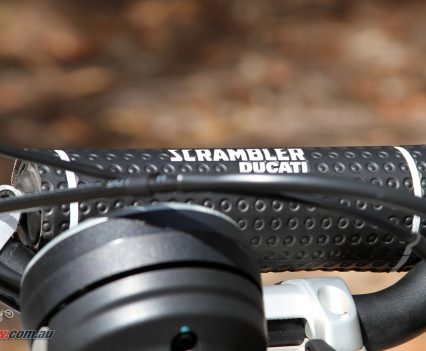
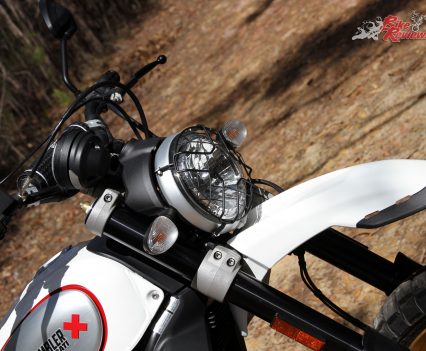
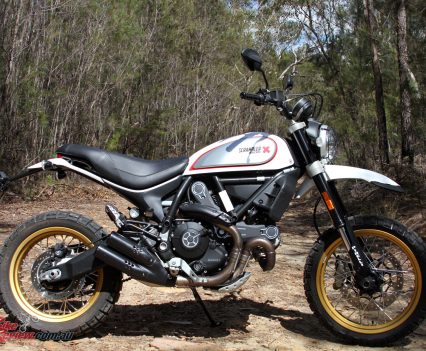
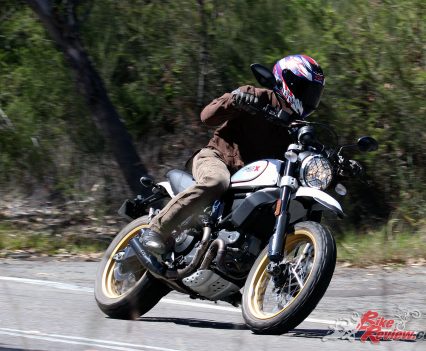
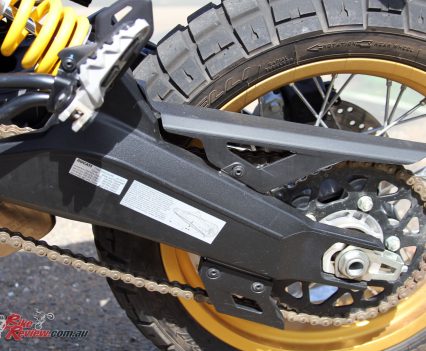
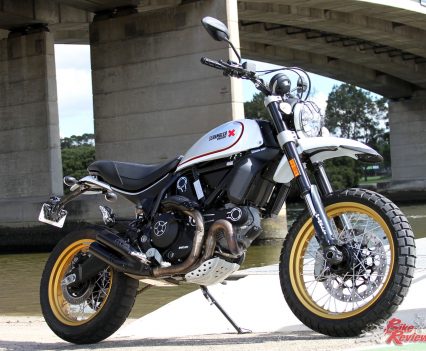
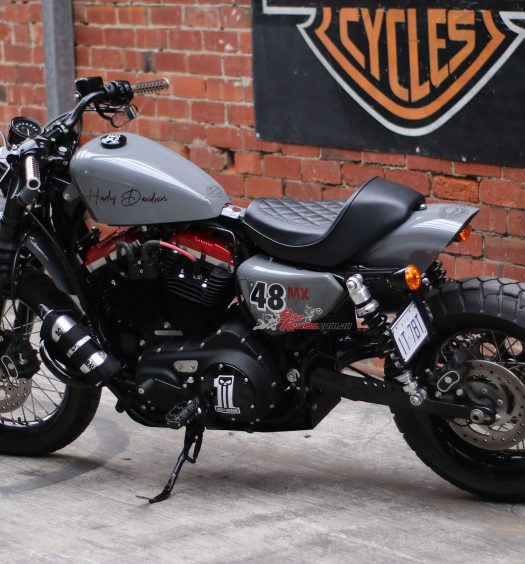
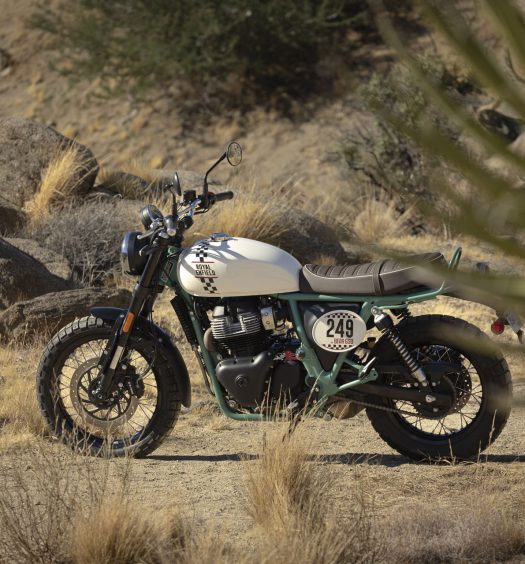
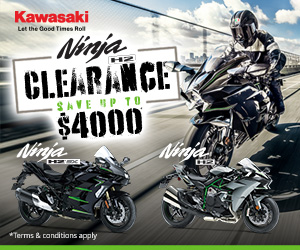



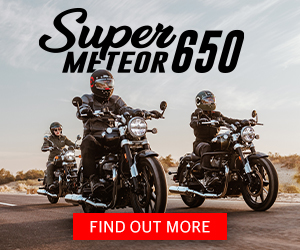
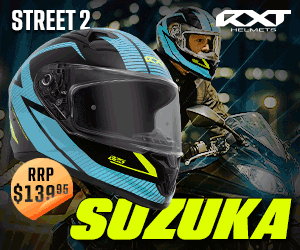







July 7, 2018
I are some issues that I’ve not seen mentioned anywhere.
From least to most concerning:
1. The gauge has a disable program built into it in case:
The bike is stolen
The gauge gets wet
The key doesn’t send the right code to the ignition
*this isn’t necessary in the United States
2. The mirrors are attached to the front brake and clutch levers. If you like the levers straight out in front as many riders do, then the mirrors point at the ground by your feet, this is a useless position. Why aren’t the mirrors atttached to the levers?
3. The fuel tank opening points north and south, 12 and 6 o’click. Sadly quality control missed a bunch of these and the cap points at 10-11 and 4-5! This is unacceptable on a bike in this price range!
**It makes you wonder if Ducati missed such a simple thing, what else did they miss?
4. The rear exhaust is on the right side directly under the passenger foot peg! The passenger will have a very very hot foot and leg. What were the designers thinking? This is just a poor design, like the mirrors! It’s a shame because this bike has the potential to be amazing!
5. The right side of the motor gets hot, very hot. Burn your leg just above your ankle bone hot! I thought my pants had caught fire and that my boot was melting. Nope, just really hot, uncomfortably, unrideable hot!
Ducati suggest you wear, “proper riding gear!” Think insulated boots so your leg doesn’t burn and riding pants. So much for a fun bike you could take anywhere and be proud of!
Damned shame Ducati and the sales team didn’t mention this before you buy the bike.
I live in Florida and this would have been a fun bike to run to a pub, the market, the gym, the beach or just putting around town without having to put on “the special riding outfit!”
July 8, 2018
Hey Steven, thanks for sharing your thoughts!
Quite a lot of bikes feature security systems which work in a similar manner, although there being problems when it gets wet is no good! Is that just in the rain or are you using a high pressure hose for washing? The latter can definitely cause issues, although I’ve had a few bikes in the past which would play up even being rinsed off with a garden hose on low pressure .
We didn’t have any problems with the fuel cap orientation, but that’s also not good.
This mirror mounting position is very common though. You could probably buy separate mounts for the mirrors so you could adjust the lever angle, but then you’re adding another piece of hardware that’s unnecessary for anyone not moving the levers like this, so it seems an unlikely choice as original equipment. You could also consider ‘bar end mirrors
We didn’t notice excessive heat on this model and we had a few 35c days during testing, although we’re generally riding in motorcycling jeans and riding boots, which provide significantly more protection, especially to your ankles and calves.
We also always recommend ATGATT – All The Gear, All The Time, but that’s a personal choice at the end of the day.